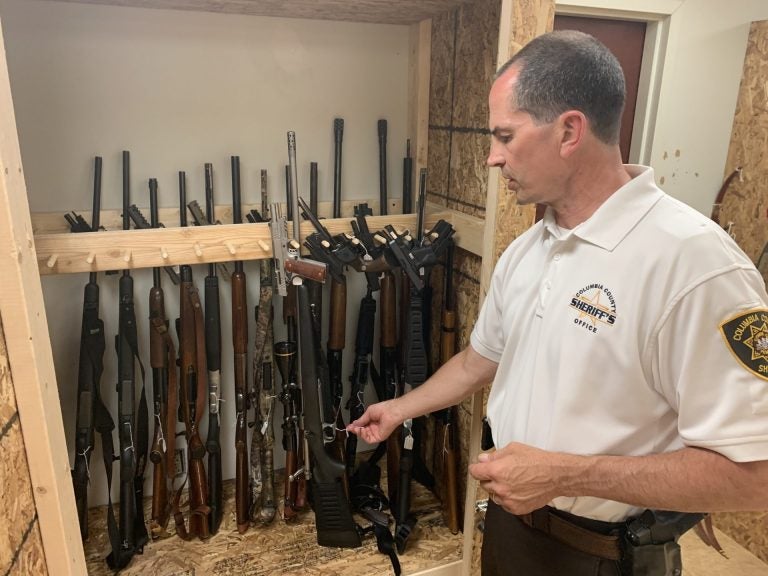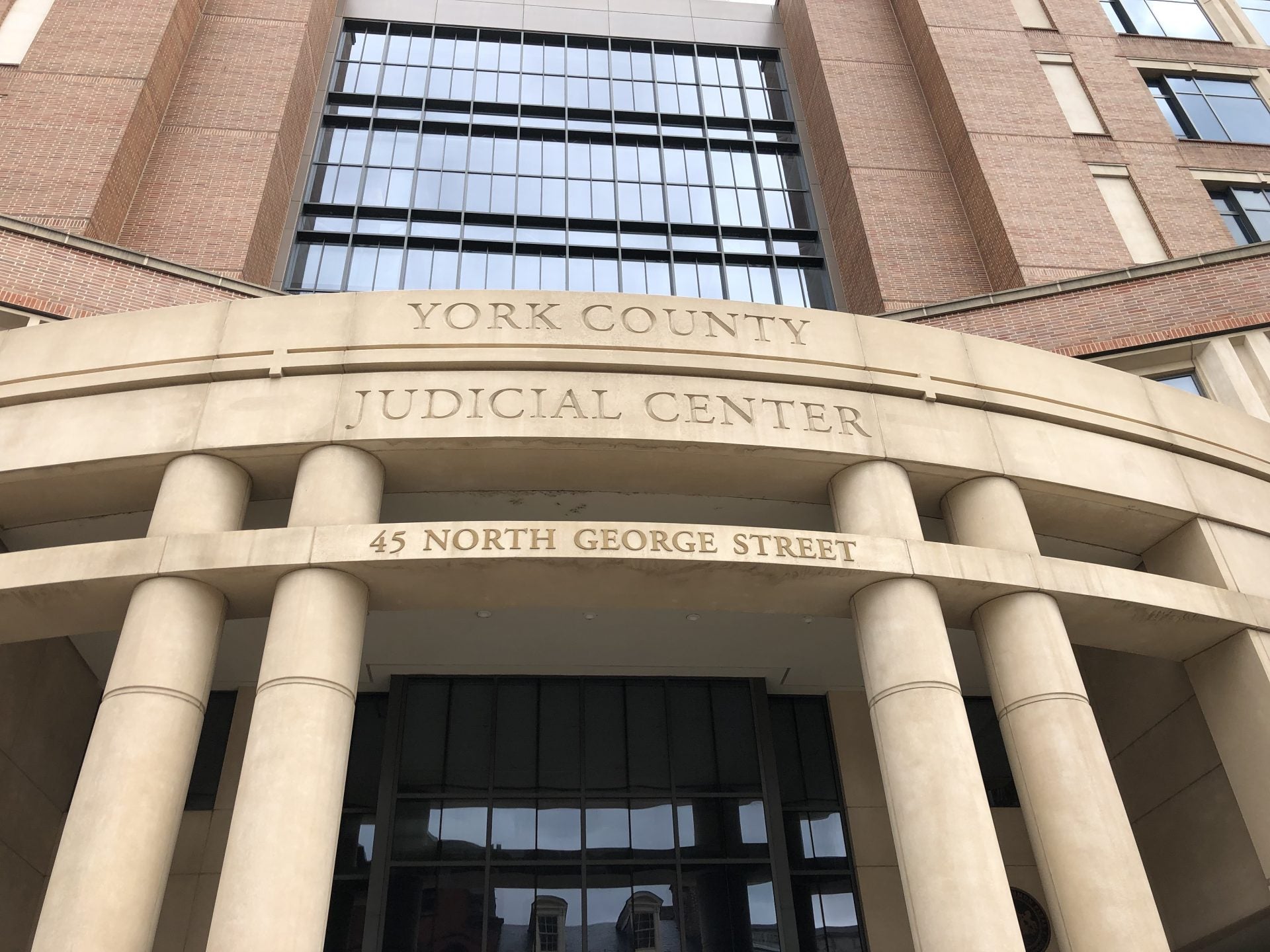For Pa. sheriffs, new law means more guns in their hands. The question is where to put them all
Act 79 took effect in April – and already, some counties are noticing an impact on weapon storage capacity and/or manpower.

The Columbia County Sheriff's Department weapons storage facility is at 75 percent capacity of its weapons storage, according to Sheriff Timothy Chamberlain. Columbia and other rural counties tend to take multiple guns -- often dozens -- from defendants ordered to relinquish their weapons as part of protection from abuse orders. (Emily Previti/PA Post)
This article originally appeared on PA Post.
—
Sheriff Timothy Chamberlain has stored confiscated firearms off-site from the county courthouse for several years.
“It’s a confidential location,” Chamberlain said, as he unlocked the door on a recent afternoon. “Obviously, there are a lot of guns here.”
More to come, if things keep going as they are.
Pennsylvania law changed nearly three months ago to require all people with a final protection from abuse order to turn over their weapons.
Before, some defendants could keep their guns and other weapons. Those that couldn’t have the option of giving them to friends or relatives – but now, only law enforcement, a firearms dealer or commercial armory, or their attorney can take possession.
Act 79 took effect in April – and already, some counties are noticing an impact on weapon storage capacity and/or manpower. As a result, sheriffs departments (which aren’t charging for storage) are seeking funding for hiring, expansion projects, technology investments, or a combination of measures.
In Columbia County, for example, the sheriff’s storage area was at 90 percent capacity as state lawmakers debated the PFA law last year in Harrisburg.
By the time they passed Act 79, Columbia’s maintenance staff had installed some additional gun racks – adding 100 spots for handguns, rifles, crossbows, knives and other weapons.
Half a year later, those additional spaces are full.
Chamberlain says he doesn’t think they’ll need to expand again in the near future. But he acknowledges it’s hard to predict storage needs because there are so many unknowns:
The number of guns defendants will turn in, how long a PFA will be active, whether defendants will be otherwise prohibited from possessing firearms in the meantime and whether they’ll want them back right away (or at all).
Recently, one PFA defendant turned in 30 guns to Columbia sheriff’s deputies.
The rifles and handguns are now in a padlocked plywood cabinet, each tagged with the owner’s name and associated case number.
“We can serve three PFAs and have another hundred guns in here. That’s what happens in a rural area,” Chamberlain said, noting the popularity of hunting. “There are a lot of gun permits in Columbia County. Probably more than 10 percent of the population has a hunting permit or license to carry concealed firearms.”
Columbia’s ratio of gun permits issued per capita is greater than most other counties in the commonwealth, ranking 14th of 67 in a PA Post analysis of state police firearms data.

A single seizure’s significance
Perry County is also rural and has a strong hunting culture. It’s 15th among counties ranked by gun permits per capita.
Sheriff Steven Hile said he sees the potential for Act 79 to drive up the inventory of seized weapons. For Hile, that’s less of a concern because the department recently moved its offices to a new space that includes more storage for confiscated firearms.
But, he said, the rollout is in its infancy. And, like Chamberlain, Hile acknowledges a single seizure could be impactful.
Within the past year, one gun collector turned over nearly 90 firearms under a PFA order (more than half the department’s storage capacity); a typical haul is more like a dozen, said Perry County Sheriff’s Deputy Jared Charles.
Manpower’s a more immediate concern in Perry County, according to Hile, and throughout the state, according to the Pennsylvania Sheriff’s Association.
Hile says Act 79 responsibilities aren’t solely responsible for overloading his deputies; rather, the additional duties under the law were the tipping point for a department already stretched to its limit and helped convince commissioners to spring for a new hire.
Pennsylvania Sheriff’s Association Executive Director Tom Maioli says departments have adjusted so far through rescheduling and shuffling around assignments. In most cases, they haven’t had to hire or pay much overtime, at least not at this point, Maioli said.
But some are looking to streamline processes linked to Act 79, increase weapons capacity or both.

‘Hard to put a number on it’
That includes more populous counties that handle more PFAs, like York, which has more than five times as many residents as Columbia (nearly 10 times as many as Perry) and PFA filings follow about the same proportions.
The York County Sheriff’s Office’s weapons storage unit is a bunker-like facility surveilled by multiple cameras. From the outside, it could be a utility closet. Inside, it’s entirely full (hence the $70,000 expansion underway) of rifles, handguns, knives and other weapons, including various bladed martial arts devices, a kitchen knife set, a baseball bat and Wolverine-esque steel claws.
“It’s hard to put a number on [Act 79],” said Assistant Chief Steven Diehl, adding capacity was nearly full when the law took effect. “But we can’t keep up with current demand.”
Last year, York started using a software program to help streamline and improve their process: seizure in the field, cataloging, storage, case tracking, etc. The department developed it in conjunction with Teleosoft, which is already a software vendor for York and other county sheriff’s departments.
Seventeen counties – including Berks, Philadelphia, Lancaster, Sullivan and Jefferson – are looking into getting the same program, according to Teleosoft Vice-President Cory Fregm.
“A key challenge for smaller county sheriff’s offices … has been finding funding, so their buying process is just slower,” Fregm said.
Local police also could be affected.
“With the new law, if they come in with their weapons, and say, ‘Hey, I have a PFA against me, here are all my guns,’ we have to take them,” said Lower Allen Township Police Captain Leon Crone. “So now, we have the storage issues that we might have to deal with.”
While this is new for municipal police, the changes are a reversion of sorts for Chamberlain and other sheriffs who remember when only their departments could take weapons under a PFA order.
“Guns being third-partied to family members, parents, siblings – I don’t think that was a smart move, considering the victims of domestic violence,” said Chamberlain, who’s been in law enforcement for three decades. “The new act kind of fixes that situation.”
Note about the data: Protection from abuse orders and firearms relinquishment data provided by state police. PA Post has requested more specific data, such as county-level breakdowns of PFA orders mandating firearms relinquishment in past years, from the Pennsylvania State Police. That data is kept in the state’s PFA database. The PSP denied one request, but PA Post is still working to get the data.
Editor’s note: This post was updated to reflect the correct cost for York County’s weapon storage expansion project.
WHYY is your source for fact-based, in-depth journalism and information. As a nonprofit organization, we rely on financial support from readers like you. Please give today.





